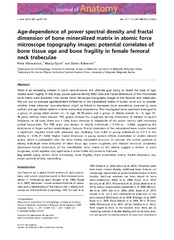Приказ основних података о документу
Age-dependence of power spectral density and fractal dimension of bone mineralized matrix in atomic force microscope topography images: potential correlates of bone tissue age and bone fragility in female femoral neck trabeculae
| dc.creator | Milovanović, Petar | |
| dc.creator | Đurić, Marija | |
| dc.creator | Rakočević, Zlatko Lj. | |
| dc.date.accessioned | 2018-03-01T22:48:33Z | |
| dc.date.available | 2018-03-01T22:48:33Z | |
| dc.date.issued | 2012 | |
| dc.identifier.issn | 0021-8782 | |
| dc.identifier.uri | https://vinar.vin.bg.ac.rs/handle/123456789/5066 | |
| dc.description.abstract | There is an increasing interest in bone nano-structure, the ultimate goal being to reveal the basis of age-related bone fragility. In this study, power spectral density (PSD) data and fractal dimensions of the mineralized bone matrix were extracted from atomic force microscope topography images of the femoral neck trabeculae. The aim was to evaluate age-dependent differences in the mineralized matrix of human bone and to consider whether these advanced nano-descriptors might be linked to decreased bone remodeling observed by some authors and age-related decline in bone mechanical competence. The investigated bone specimens belonged to a group of young adult women (n = 5, age: 2040 years) and a group of elderly women (n = 5, age: 7095 years) without bone diseases. PSD graphs showed the roughness density distribution in relation to spatial frequency. In all cases, there was a fairly linear decrease in magnitude of the power spectra with increasing spatial frequencies. The PSD slope was steeper in elderly individuals (-2.374 vs. -2.066), suggesting the dominance of larger surface morphological features. Fractal dimension of the mineralized bone matrix showed a significant negative trend with advanced age, declining from 2.467 in young individuals to 2.313 in the elderly (r = 0.65, P = 0.04). Higher fractal dimension in young women reflects domination of smaller mineral grains, which is compatible with the more freshly remodeled structure. In contrast, the surface patterns in elderly individuals were indicative of older tissue age. Lower roughness and reduced structural complexity (decreased fractal dimension) of the interfibrillar bone matrix in the elderly suggest a decline in bone toughness, which explains why aged bone is more brittle and prone to fractures. | en |
| dc.relation | info:eu-repo/grantAgreement/MESTD/Integrated and Interdisciplinary Research (IIR or III)/45005/RS// | |
| dc.rights | openAccess | en |
| dc.source | Journal of Anatomy | en |
| dc.subject | aging | en |
| dc.subject | atomic force microscopy | en |
| dc.subject | bone fragility | en |
| dc.subject | bone mineralized matrix | en |
| dc.subject | fractal dimension | en |
| dc.subject | hip | en |
| dc.subject | power spectral density | en |
| dc.subject | remodeling | en |
| dc.title | Age-dependence of power spectral density and fractal dimension of bone mineralized matrix in atomic force microscope topography images: potential correlates of bone tissue age and bone fragility in female femoral neck trabeculae | en |
| dc.type | article | en |
| dcterms.abstract | Ракочевић Златко Љ.; Дјуриц, Марија; Миловановиц, Петар; | |
| dc.citation.volume | 221 | |
| dc.citation.issue | 5 | |
| dc.citation.spage | 427 | |
| dc.citation.epage | 433 | |
| dc.identifier.wos | 000309454500005 | |
| dc.identifier.doi | 10.1111/j.1469-7580.2012.01556.x | |
| dc.citation.rank | M21 | |
| dc.identifier.pmid | 22946475 | |
| dc.identifier.scopus | 2-s2.0-84867220857 | |
| dc.identifier.fulltext | https://vinar.vin.bg.ac.rs//bitstream/id/4834/joa1556.pdf |

